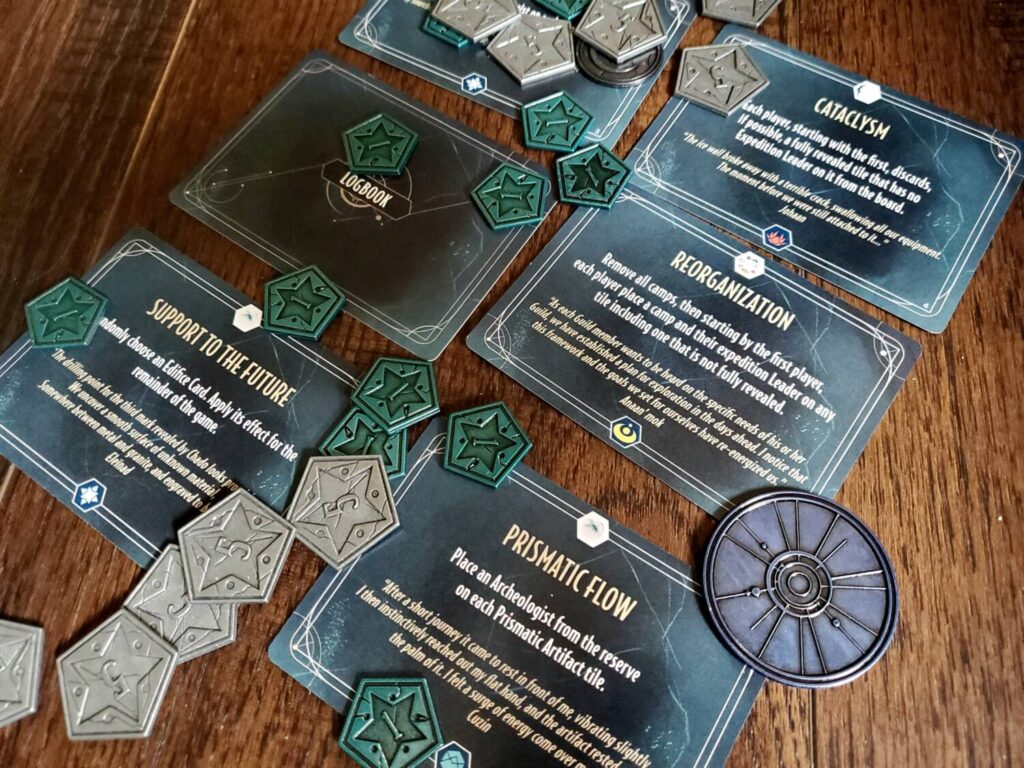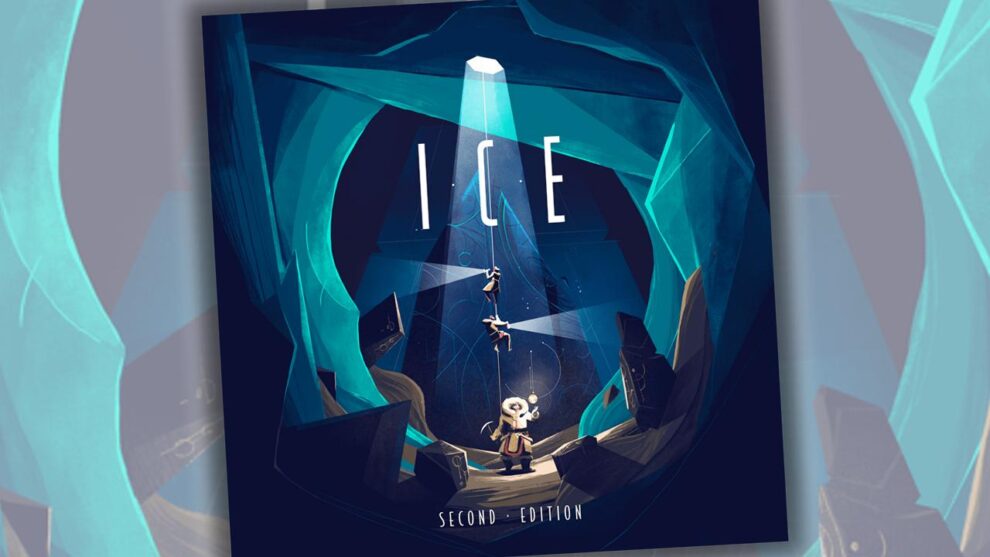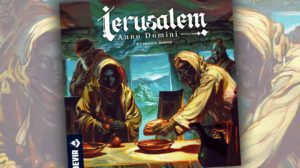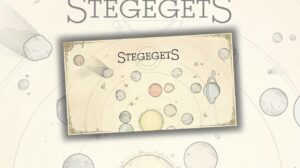Disclosure: Meeple Mountain received a free copy of this product in exchange for an honest, unbiased review. This review is not intended to be an endorsement.
Second editions speak. For a game that has circulated and expanded for years, they speak of the desire for a consolidated experience, like Camel Up, London, or Nemo’s War. Of course, sometimes they stir mixed reactions, creating a clamoring for the original (Sheriff of Nottingham, anyone?). For a newer release, second editions might speak of unrelenting demand or lessons swiftly learned from a wide release and the ensuing abundance of consumer feedback.
In the case of I C E, the forthcoming Second Edition speaks a message of access—budgetary access. The original campaign boasted one of the most intriguing deluxe game boards that I can recall, but it was expensive. The matching premise was also fascinating: digging through layers of icy hex tiles to collect goodies. I was so close to backing the first edition. In the end, though, my budget got in the way. I really wanted every bell and whistle in the catalog, but my wallet shut the whole thing down.
In every way, then, I am the target audience for this new release. The team at This Way! had always planned for a retail-level release to complement their behemoth, but lacked the means to pull it off in the first funding push. The upcoming campaign will introduce a scaled-back version of the original, with simplified (but still impressive) components and streamlined play—more
I C E for everyone. I was pretty excited to sit with the prototype because I am a scaled-back, streamlined, simplified kind of guy.
There’s snow place like…
Four magnetic quadrants snap together to form the hex-shaped bowl into which three layers of icy hex-shaped tiles lay. As the game begins, the players face a snowy landscape with tunnels, rifts, and craggy nunatak. The undersides of these top-layer tiles feature single-use abilities. The two lower layers feature Artifacts that are desirable both for their immediate power and their eventual point value. Waiting at the very bottom, the frozen city of Azulia is ripe for lucrative uncovery (I know that’s not a word, but discovery doesn’t quite fit).

On the scorepad, I C E is a patterned set-collection game. Players seek to satisfy the conditions of three generic public Decrees and a growing hand of private Requests. The target? Artifacts, each containing a color, a structure, and an Anima (strength). The objective cards make demands upon these features. The only other source of points are coin tokens representing Renown points, all of which are earned via the pursuit of the patterned sets.
Atop the scoring infrastructure lies a game of exploration. Players send their expedition leaders out to move, gather help, excavate, and extricate the goodies.
It’s snow use…
Players begin each of the game’s four days with five Exploration points. A typical turn consists of stretching one or two points as far as possible in the name of collection. Unless aided by some special ability, movement always comes at a cost, either trudging tile to tile or (seemingly) flying to established camps. In order to excavate, expedition leaders pick up Archaeologists—minions—along the way. These extra mini-meeples follow leaders and orders, not out of any sense of loyalty but rather because the leaders happen to be nearby. This cloud of humanity offsets the cost of digging, most often to the point of being free. While there is a limit to point expenditure, there is no limit on action if a player is thrifty and prepared.
Top-layer tiles require less effort to excavate in most cases, but as tiles are removed, the various meeples must be evenly distributed among the revealed tiles below. In this way, the help is repeatedly scattered, preventing uninterrupted digs until the band gets back together.
Rounding out the options, players might use Exploration points to call for backup Archaeologists, purchase a pseudo-Artifact, or defer Exploration points to the next round. In a pinch, a Renown point might fly to extend a turn in the name of efficiency or greed.

As players dig down, additional rules kick in regarding excavation. It is possible to dig an Artifact out before it is entirely uncovered, with the snowy layer above becoming a discard; but there are also limits, as two top layers make the dig impossible. One of the more fun rules forces the collapse of a tile when it is only connected on one side. Cave-ins are exciting (and satisfying when they are intentionally managed) and change the landscape quickly.
At the end of the day, players have the opportunity to offload a limited number of their Artifacts to the cargo hold of their ship (a.k.a the table). This decision is more interesting than it sounds, though, because player boards carry special per diem abilities that are charged (so to speak) by the Artifact tiles. Without sufficient Anima points on the collected tiles, the abilities disappear. From day to day, players are faced with decisions of which ability to keep and which to discard in the name of endgame scoring. In addition to offloading, players use this time to possibly purchase an additional Request card to increase private scoring opportunities.

Renown tokens—the only other source of scoring—arrive in two primary ways. First, each offloaded Artifact provides one as a bonus. Second, when a player fully uncovers one of the shapes printed on the bottom of the board (the city), they receive a token. This actually creates an interesting race and tension as players want to be the one to finish the “uncovery” process. I can’t call it discovery because it’s not even necessary that a player’s expedition leader be on the tile, only that they bring it to light.
New days begin with a reset and the revelation of a Logbook card—an event that will shift the board state in one way or another. At the end of the fourth day, the game ends and the tallies begin.
It’s snow big deal…
Our copy of I C E: Second Edition contained materials from the Guilds and Edifices expansions. These bonus modules add bits of flavor to the icy world. The Guilds lend more and greater player powers to the expedition leaders. The Sentry Wurm chases explorer pawns away to their adjacent spaces, and then again as players each take daily turns moving the critter about. The Accelerator Antenna speeds the removal of certain Artifact tiles, moving the game along at a breakneck pace. The Monolithic Lotus grants an offsetting bonus of Exploration points to the player(s) with the fewest Artifacts to start each day.
These ideas continue, granting Renown point tokens, changing the collapse conditions, etc. until players work through the entire booklet. The variations could easily serve as a scenario-based system through which to explore the world.

It’s snow problem…
We were only playing a prototype, but this game is a looker and oozes its theme. I know the first edition had the massive, five-layered, wooden-tiled board that was 100% high society; but in many ways I celebrate the simplified retail edition. The cardboard bowl is great and the magnetic assembly works well. The art is delightful and fits the gameplay like a glove. Our box had metal coins, too. If I hadn’t seen the original Kickstarted title, I could be convinced that I was holding the deluxified version—and I’ve yet to see the aesthetic fineries in the forthcoming campaign.

Setup is unusual. It’s impossible to layer the tiles without someone knowing the general locations of some of the Artifacts beneath the snow. This creates an interesting quandary: should players just watch as part of the strategic vision, or should they try their darndest to forget what they saw? It sure seems openness is the better option, but any choice undermines a genuinely blind dig-and-search operation.
On that same note, I witnessed frustration in some of the set collection efforts. Certain objective cards require specific symbols or numbers of marks on the tiles. None of these marks are visible until after a tile is claimed (and the marks were unnecessarily small in the prototype). As such, it is entirely possible to exert turns of effort in the name of a tile that doesn’t quite satisfy a need. Real life arctic digging, I imagine, is the same; but on the tabletop that scenario is occasionally annoying.

One final concern: If players are active and thoughtful with their turns, it’s possible to thin the tiles pretty severely by the end. We did not play with four or five players, but it sure seems possible to gut the board, leaving very little to chase during the final day. At the very least I’ll say players must remain keenly aware of the board state as turns wind down if they’re to make anything significant happen amid a scarcity of options. Some of the final turns have been underwhelming even without the full complement of humanity at the table.
On the positive side the various player Guilds and their special abilities are all supremely interesting and seemingly balanced. Being able to grapple down to the next level without distributing the meeples evenly is fascinating. Gaining a bit of flexibility with the camp can be quite potent. Owning the right to dumpster-dive through the discarded tiles is likewise engaging. These changes do make a difference in strategy and give a different feel to each play.
The first edition rules were a little different, but I love that there are only three layers; and I love the point bonuses for uncovering the city regions in the bottom of the bowl. It’s not exceptionally difficult to alter the board state, which always has I C E feeling like something is happening. As the Artifacts come into sight, they pull eyes and attention. As the outlines on the base of the bowl come into view, players are jockeying to be the ones to complete the “uncovery” operation. As the game wears on, the temptation to spend Renown to take a beefier turn becomes real. Sometimes it’s all about getting there first, and as the points wear thin, the race matters. I C E leaves no shortage of interesting decisions. The efforts to create a more compact experience, I would say, have succeeded.
There’s snow crying in…
There are three realities that I have been trying to reconcile in my head. First, the ending is simple. There is a scorepad, but it’s only to ease a bit of arithmetic. In teaching the game, I would always begin with the scoring, because folks need to see just how basic an idea they are chasing. Collect Artifacts—twelve at most—for maximized scoring potential. This isn’t a bad thing, but perhaps it is unexpected for all the detail in the rules.
Second, the setup is sensible, but takes time and creates the unfortunate reality of prescient knowledge. It’s likely you’ll know more than feels appropriate.
Third, the journey is somewhat elaborate. Players choose from eight actions each turn, some of which have a cost, some of which are free, all of which might combine into bonkers combinations. There are five Artifact actions that might provide (free) aid in a given day/round and that must be weighed against those eight possible actions. There are five categories of snow tiles providing single-use abilities. And there are delightfully tense decisions at the end of each day as players choose what to keep and what to pack away for points.

In short, I’m unsettled about whether a game that requires such setup and demands such effort for such a tame goal will have longevity. There are varieties galore in the box. The entire experience is an aesthetic marvel. The exploration is interesting, and there are absolutely satisfying turns along the way. And yet, I felt an indescribable disconnect somewhere between learning all those rules and filling out the scorepad, almost as if there was an invisible ceiling on my motivation.
Nevertheless, we’ve had fun and I am excited to play the finished product. I C E is the marriage of an innovative idea with a sense of grandeur and style. The Second Edition definitely makes the total package more accessible. If you’re interested in lacing up your snow boots, check out the campaign on Gamefound.











Man, this is a tough one. I respect MM’s opinion because I love your website and your articles are so well-written. But I would have hoped for a higher score from you if I was going to back this confidently. Not sure now. The big question I have for anyone who’s played it is if you have crunchy decisions to make throughout the game. I would have thought there weren’t many because the gameplay does not seem that deep to me. But then I see some really strong positive reviews so I start second-guessing. I don’t know.
Greetings Jacob! Thank you for the kind words. ICE is a solid game, and the more overtly positive reviews are definitely merited. I genuinely believe the breadth of gameplay options will allow for a variety of enjoyable experiences. It was well received, but I always try to mine out the reasons behind any hesitations. It’s the sort of game where I can see what everyone is saying, but I also see something in myself and my preferences that gets in the way. I’ve not had a chance to play since the prototype, though, so my thoughts aren’t as fresh all these months later.